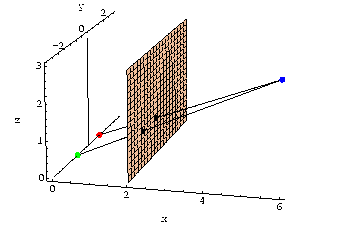Math 210--Linear Algebra: Project 2, Spring 1999
Navigation in a peculiar world...
by Gavin LaRose
(glarose@umich.edu),
Nebraska Wesleyan University, February 1999
©1999 Gavin LaRose (glarose@umich.edu)
permission granted to use and distribute free in an academic
setting.
-
- PostScript
version of project
Satellite Allocation Division
1 Piecemeal Dr.
Haoma, SK 13681-0050
1 March 1998
Linear Mathematics, Inc.
Suite 6, Strawmarket Business Plaza
Lonlinc, SK 04685
Dear LMI:
 As you are undoubtedly aware, in the past year momentous events were
seen in the field of extraterrestrial exploration, with (among other
things) an unmanned rover being dispatched to Mars to obtain a wealth
of data. It is our distinct pleasure to be in the process of
developing a similar roving vehicle for use on planets or asteroids
even farther from Earth, and it is in the development of the
visualization portion of the navigation system for this vehicle
(tentatively christened ``Sam'') that we seek your input.
As you are undoubtedly aware, in the past year momentous events were
seen in the field of extraterrestrial exploration, with (among other
things) an unmanned rover being dispatched to Mars to obtain a wealth
of data. It is our distinct pleasure to be in the process of
developing a similar roving vehicle for use on planets or asteroids
even farther from Earth, and it is in the development of the
visualization portion of the navigation system for this vehicle
(tentatively christened ``Sam'') that we seek your input.
The model for this vision system is shown in the figure to the right.
This shows two cameras (the light-colored dots to the lower left of
the figure) and an object being viewed (the darker dot to the upper
right of the figure). Each of the cameras (Sam's ``eyes'') therefore
``sees'' the object as a projection on a virtual screen (the camera
lenses, if you like), as shown in the figure by the dark dots where
the line-of-sight of the cameras to the object intersect
the virtual screen (the plane shown).
From the two two-dimensional projections (which are points
(y,z) in
the plane of the virtual screen shown) that Sam ``sees,'' we need to
be able to determine the actual location of the object (which will be
a three-dimensional location, (x,y,z)). Our
engineering division
produced a tentative method for calculating this location, but we
found on examination that the location it predicted was plagued with
errors which may be due to measurement error in the screen-projections
for either camera. We are therefore contacting you to obtain a more
robust method of doing this. As it is possible to scale lengths on
arbitrary scales, you may wish to consider the cameras as being
located at (0,+/- 1,0) and the virtual screen at x=2.
As is our custom, we have established contact in the local scientific
community to act as a liasion between your company and our own
division, this being the formidable
Dr. maybe-the-P.-stands-for-prominent Gavin LaRose. Your written
report on this matter should be submitted by the 19th of March. If
you should find that you have questions regarding this project,
Dr. LaRose has indicated that he would be quite happy to provide
whatever assistance he is able to give. We regret, however, that
owing to other responsibilities he will be unavailable to assist on
this project any later than the 17th of March.
We look forward to receiving your report.
Sincerely
Dr. Vern R. Von Brawn
Head Scientist, SAD
vrvb:glr
Gavin's LinAlg Project 2, Spring 1999
Last modified: Sun Feb 28 20:02:31 CST 1999
Comments to
glarose@umich.edu
 As you are undoubtedly aware, in the past year momentous events were
seen in the field of extraterrestrial exploration, with (among other
things) an unmanned rover being dispatched to Mars to obtain a wealth
of data. It is our distinct pleasure to be in the process of
developing a similar roving vehicle for use on planets or asteroids
even farther from Earth, and it is in the development of the
visualization portion of the navigation system for this vehicle
(tentatively christened ``Sam'') that we seek your input.
As you are undoubtedly aware, in the past year momentous events were
seen in the field of extraterrestrial exploration, with (among other
things) an unmanned rover being dispatched to Mars to obtain a wealth
of data. It is our distinct pleasure to be in the process of
developing a similar roving vehicle for use on planets or asteroids
even farther from Earth, and it is in the development of the
visualization portion of the navigation system for this vehicle
(tentatively christened ``Sam'') that we seek your input.